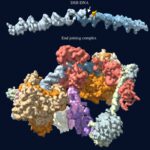Lien vers Pubmed [PMID] – 11058843
Lien vers HAL – Cliquez ici
Lien DOI – 10.1107/s0108767300010242
Acta Crystallogr A. 2000 Nov;56(Pt 6):562-74. Erratum in: Acta Crystallogr A. 2001 Jan;57(Pt 1):118.
The mean-field optimization methodology has been used to recast in a single formalism the problem of phase optimization using an arbitrary energy function in the presence of an experimentally determined phase probability distribution function. It results naturally in the generalization of the notions of figure of merit and centroid phase where the weight of the energy refinement is controlled by an effective temperature in a self-consistent manner. In the limit of high temperature, the formalism reduces of course to the Blow & Crick [Acta Cryst. (1959), 12, 794-802] classical treatment. If a model is available, Sim’s [Acta Cryst. (1960), 13, 511-512] weighting scheme for a combined map appears as the first step of a refinement to be conducted until self-consistency is achieved. Assuming that MIR phases exist and that they agree reasonably well with the phases of the model, a first-order expansion gives an estimate of the changes of weights and phases to be performed for the Fourier synthesis. This provides for a new way of doing phase combination that might prove useful in challenging cases of model refinement, e.g. in large macromolecular complexes. Thermodynamic considerations have been used to discuss the best determination of weights in phase refinement; they also suggest that a variational expression of maximum likelihood is best suited as a target for refinement because it is the free energy of the system. The formalism readily allows use of solvent flattening, density averaging and the atomicity criterion to refine phases, and automatically assigns a figure of merit to each reflection. Numerical tests of the method are presented in an attempt to resolve the phase-ambiguity problem of protein crystallography in the centrosymmetric P¿1¿ space group using an energy derived from the Sayre equation.

